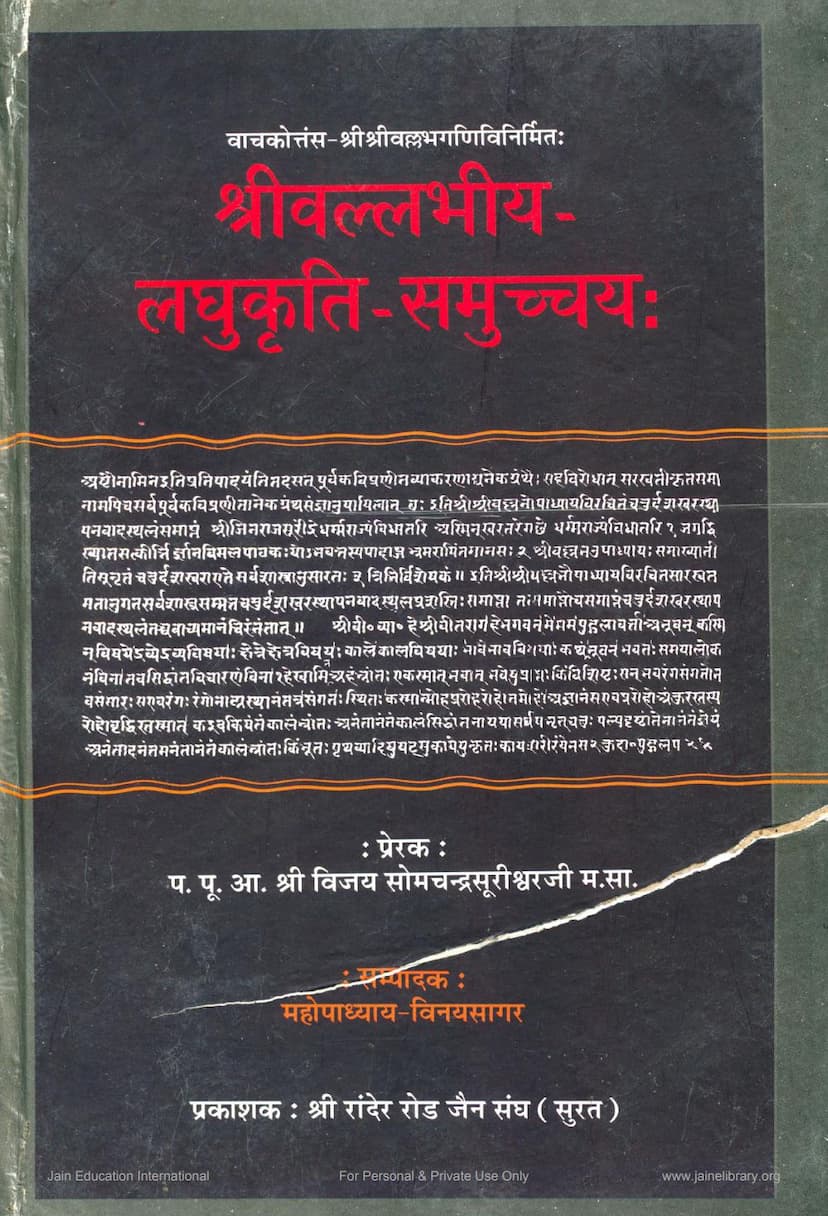Vallabhiya Laghukruti Samucchaya
Added to library: September 2, 2025

Summary
This is a comprehensive summary of the Jain text "Vallabhiya Laghukruti Samucchaya" by Vinaysagar, published by Rander Road Jain Sangh. The summary is based on the provided page content, which includes title pages, introductory remarks, the main body of the work, and appendices.
Book Title: श्री श्रीवल्लभीय-लघुकृति-समुच्चयः (Shri Shri Vallabhiya Laghukruti Samucchaya) Author: श्रीवल्लभ (Shri Vallabh) Editor: महोपाध्याय-विनयसागर (Mahopadhyaya Vinaysagar) Publisher: श्री रांदेर रोड जैन संघ (Shri Rander Road Jain Sangh), Surat
Overall Purpose:
The "Vallabhiya Laghukruti Samucchaya" is a collection of fourteen minor works (laghukruti) by the learned scholar and poet Shri Vallabh. These works cover various aspects of Jain philosophy, grammar, poetics, and literature. The publication aims to bring these valuable, often overlooked, works to a wider audience, making them accessible to scholars and practitioners of Jainism.
Key Themes and Content:
-
The Author, Shri Vallabh:
- Shri Vallabh was a scholar, poet, and Vacanaacharya (master of discourse) from the Kharatargachchha tradition.
- He was a disciple of Upadhyay Shri Gyanvimalji.
- His lineage traces back to prominent scholars like Upadhyay Jayasagarji, who lived in the 15th-16th century.
- Shri Vallabh is praised for his erudition across various subjects including grammar (linguistics), lexicography, poetry, and philosophy.
- He is noted for his broad-mindedness and respect for scholars from other traditions, as evidenced by his work "Vijaydev Mahatmya" which praises a Tapa-gachchhiya Acharya.
- His works are characterized by their adherence to pure literature, free from sectarian biases.
- He was a significant contributor to the revival and preservation of Jain literature.
- His writings suggest a strong connection to the Rajasthan region in his formative years, evidenced by the use of Rajasthani dialect and words.
- His literary output spans from around 1630-1640 CE (for his initiation) to after 1675 CE, and possibly up to 1687 CE or shortly after for his demise.
- He held esteemed positions like Vacanaacharya and Gani, and later possibly Upadhyay.
-
The Fourteen Minor Works (Laghukruti): The collection comprises fourteen distinct works, including:
- Matruka Shlokamala: A poetic work structured around the Sanskrit alphabet, praising the 24 Tirthankaras and other entities. It showcases his mastery of prosody and vocabulary.
- Vidyat Prabodh Shastra: A work derived from the Koshas (lexicons) of Soubhari, focusing on descriptive poetry, particularly of animals. It's noted for its complex wordplay and linguistic expertise.
- Shri Parshvanath Stotra: A stotra (hymn) praising Lord Parshvanath, characterized by the Yamaka (alliteration/rhyme) अलंकार (figure of speech).
- Timiripureshwar Shri Parshvanath Stotra: Another stotra dedicated to Lord Parshvanath, specifically mentioning the location Timiripur, and is noted for its "Samasya" (riddle-like composition) style.
- Shri Ajitnath Stuti (Mularthapariharrup Vyakhya Dvaya Samvalita): A commentary on a hymn to Lord Ajitnath, where Shri Vallabh reinterprets a hymn originally by Jayasagarji, offering new meanings. This highlights his analytical skills and theological depth.
- Shri Shantinath Vishamarth Stuti Tika: A commentary on a hymn to Lord Shantinath, similar in style to the Ajitnath Stuti commentary, demonstrating his interpretive prowess.
- Prashnottaraikshashtishataka Kavya Tika: A commentary on a philosophical work by Jinavallabh Suri, showcasing his knowledge of grammar, logic, and various philosophical texts.
- Kesha: Kanjalika Shabha Padya Vyakhyā: An explanation of a verse from Sarasvat Vyākaraṇa, illustrating the meanings of certain words with a focus on linguistic nuances.
- Khacharanan Pashya Sakhe Khachara Padya Vyakhyā-Trikam: Explanations of a verse with three different interpretations, showcasing his versatility in understanding and expounding texts.
- Yāmātā Padya Artha Panchakam: Explanations of a verse with five different interpretations, demonstrating his deep knowledge of lexicography and philology.
- Okeshopakesh Padadvaidasharthi: A work explaining the etymology and multiple meanings of the terms "Okesha" and "Upakesha," likely related to the lineage or identity of a particular Jain sect or tradition.
- Khara-tar Shabda Navarthi: A work that provides nine different interpretations or meanings for the word "Kharatar," likely referring to the Kharatargachchha tradition.
- Chaturdasha Swar Sthapan Vadsthal: A treatise on phonetics and grammar, arguing for the existence of fourteen vowels based on various grammatical traditions, refuting the view of only nine vowels. This shows his engagement with linguistic debates.
- Chaturdasha Gunasthan Swadhyay: A devotional work in vernacular language (likely Gujarati or Rajasthani based on the script) explaining the fourteen stages of spiritual development in Jainism.
-
Editorial and Publishing Aspects:
- The book is presented as a collection to preserve and disseminate Shri Vallabh's contributions.
- The publication was motivated by a desire to commemorate spiritual events and was supported by the Shri Rander Road Jain Sangh.
- The editors, Mahopadhyaya Vinaysagar and Dr. Narayan Shastri, are credited with bringing this work to light through their dedicated efforts.
- The publication includes extensive historical context about Shri Vallabh, his guru parampara (lineage), and the significance of his works, particularly highlighting his broad-mindedness and scholarship.
- The appendices include detailed lists of works cited and the scholars and figures mentioned, providing valuable bibliographic and historical information.
Overall Significance:
The "Vallabhiya Laghukruti Samucchaya" is a significant contribution to Jain studies, shedding light on the lesser-known but highly valuable works of Shri Vallabh. It demonstrates his intellectual prowess, his dedication to preserving Jain heritage, and his ability to engage with complex subjects like grammar, philosophy, and poetry with great skill. The detailed introduction and appendices provide a rich historical and scholarly context for understanding his place in Jain literary tradition.